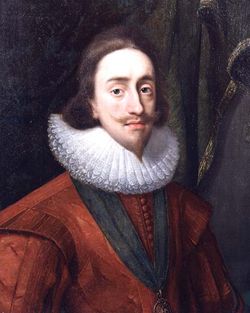On the 27th March 1625 Charles I ascended to the thrones of England and Scotland on the death of his father King James I & VI.
 |
| King Charles I |
James VI of Scotland had succeeded to the Scottish throne in 1567. He was the only son of Mary Queen of Scots and Henry Stuart, Lord Darnley, both of whom were great-grandchildren of Henry VII of England through his oldest sister Margaret Tudor. When Elizebeth I died childless on 24th March 1603, it was this lineage that saw the English throne pass to James. Thus he became James I of England and James VI of Scotland and the monarchical lineage passed from the House of Tudor to the House of Stuart.
 |
| House of Stuart Royal Arms |
Charles therefore inherited the thrones of two separate nations each with their own parliaments, judiciaries, and law.
Charles realm included Ireland. James I and VI had officially sanction the Planation of Ireland in 1609. This was an organised colonisation of a mainly catholic Ireland with settlers who in the main were protestant immigrants from Scotland and northern England. This colonisation, together with wealthy English landlords taking over lands, meant simmering tensions existed in Ireland.
Charles like his father believed in the divine right of Kings, that the monarch was accountable to god and not an earthly authority such as Parliament. He saw Parliament merely as a conduit to pass laws to enact his policies, as well as a means to raise taxes to meet the King's expenditure, in particular the costs of the military engaged on campaigns decided by the King.
Parliament could only be convened on by order of the King and he could dissolve it when ever he wished.
 |
| King Charles I believed in the divine right of Kings |
When Charles came to the throne, continental Europe was at war. War began in 1618, when Ferdinand II was deposed as King of Bohemia and replaced by Frederick V of the Palatinate (Rhineland), who was married to Charles's sister Elizebeth. The conflict escalated to become a struggle between the Lutheran and Catholic states of the Holy Roman Empire and a power struggle for dominance between the Habsburgs of Spain and Austria, and the French House of Bourbon.
 |
| Conflict in Europe within the Holy Roman Empire |
In 1624, the anti-Catholic sentiment of Parliament, as well as Charles's(then Prince of Wales) desire to support his sister in Lutheran Rhineland led to the authorising of funds for war. A mercenary army under the command Count Mansfield for service in the Palatine was raised, and the strengthening of the English navy.
Shortly after becoming King, Charles married by proxy Princess Henrietta Maria of the French Bourbon family. The princess was a Roman Catholic and the marriage was opposed by many Parliamentarians fearful that Charles might make concessions to Catholics and undermine the Church of England.
 |
| Princess Henrietta Maria |
Charles was crowned King of England at his coronation at Westminster Abbey 2nd February 1626.
 |
| Coronation King Charles I Westminster Abbey |
It would be 7 years before Charles would hold is coronation in Scotland. He travelled north staying at Raby, Aukland and Durham castles en route. He visited Newcastle on 3rd June and Tynemouth on 5th June 1633. He was crowned at St Giles Cathedral in Edinburgh on 18th June.
 |
| Coronation King Charles I Edinburgh |
